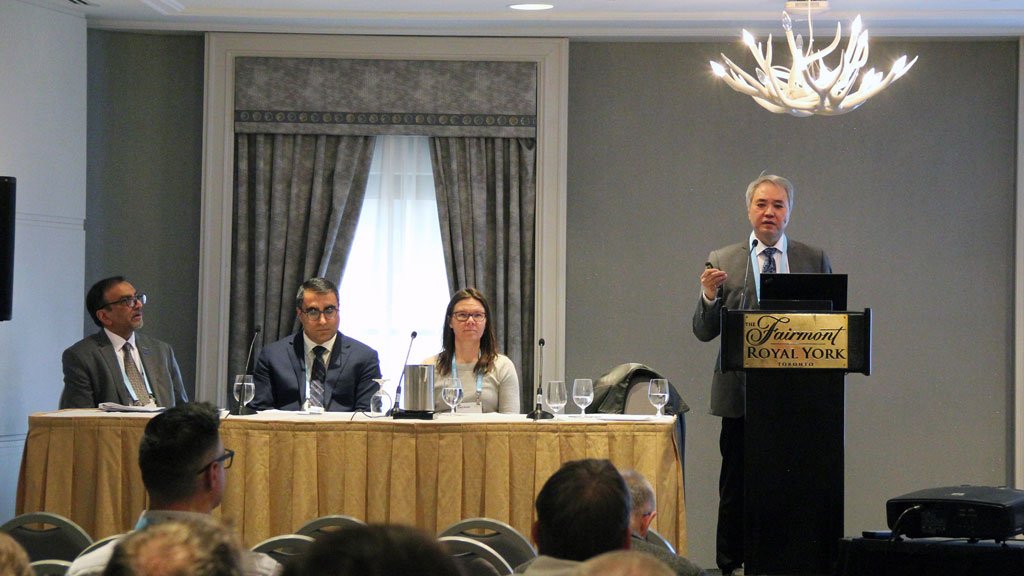New ideas and innovative solutions for reducing greenhouse gases and raising sustainability standards for asphalt use were showcased at one of the seminars at the recent Good Roads conference in Toronto.
As all three members of a green infrastructure panel made abundantly clear, ongoing and continuously improving initiatives are critical to achieve Canada’s legislative target of net-zero emissions by 2051.
Sustainability in road construction, including the use of Reclaimed Asphalt Pavement (RAP) has been a long-term commitment by the Ontario Ministry of Transportation, said its paving section head, Stephen Lee.
He described sustainability in road construction as “meeting our own needs without compromising the ability of future generations to meeting their needs.”
It’s an endeavour based on three critical factors: Economy (or cost), long service life and the implementation of GreenPave design and construction initiatives, which contractors can be rated on.
A GreenPave sustainability project rating consists of two stages. The design stage is where the greenness of design alternatives and an evaluation of post-construction information to complete the final rating are conducted. Contractors can obtain up to maximum of 32 points and be awarded either a bronze, silver or gold certification.
Lee went on to explain the ministry actively promotes the integration of sustainable pavement practices, using recycling, resource conservation and material transportation reduction, as well emphasizing the conservation of natural aggregates in highway construction.
As an example, he cited an innovative 100 per cent RAP plant cold mix trial on a section of Highway 3 in Cayuga in 2023. It was designed and installed as a base asphalt course covered by a mix asphalt surface wear course.
The advantage of a 100 per cent RAP plant cold mix is that large amounts of RAP can be recycled into a high value asphalt mix, he said.
A second just-tendered trial will be conducted this year along a section of Highway 11 in the Englehart area, said Lee.
Using RAP in an asphalt mixture will go a long way to benefiting the climate. A 40-per-cent use can achieve as much as a 15 per cent kilogram reduction in CO2 emissions, said Canada CRM general manager Sina Varamini.
As part of his presentation, Varamini highlighted the potential of using rubberized modified asphalt in very large projects.
“Rubberized modified asphalt is a complex, highly engineered composite for a wide range of loading and climatic applications.”
While stressing that material recycling is crucial, Varamini went on to say that it’s not enough.
Citing the threats to the planet from climate change, ever-increasing traffic and extreme weather events, he warned a shift in thinking and action is needed.
“We (society) tend to stay on the side of caution, relying on previous experiences and conventional materials and process.”
There is a need for policies and incentives and “leadership commitment” on the integration of specs and projects, said Varamini, noting that is happening.
For example, there is growing interest in Environmental Product Descriptions or “nutritional labelling for asphalt mixtures documents.”
Now already well in place for asphalt producers in the United States through the National Asphalt Pavement Association, the labels would list the materials that went into producing the asphalt mixture.
At its fall seminar last November, the Ontario Asphalt Pavement Council announced it is working with NAPA and the National Research Council to bring a Canadian equivalent to Ontario.
On the other side of the Atlantic, Norway has implemented a “Buy-Clean” policy, which ensures road projects are awarded to the lowest bidder after a CO2 price adjustment, said Varamini.
In an interview after the conference, he predicted similar policies will be implemented in Canada in four or five years.
Not all material recycling takes place on large road projects, the audience was told. Examples of successful applications of material recycling on small scale projects were provided by the third speaker, PTech Engineering Solutions Inc.’s principal engineer Vimy Henderson.
In 2023, the firm did an evaluation of the performance of five two-to-nine-year-old sites in southwestern Ontario where permeable rubber pavement was used. They included three multi-use paths, a park entrance built on a slope, and a private driveway.
“All five performed well and had good drainage,” Henderson said.
Permeable pavements are an ideal low impact development for areas used by pedestrians, cyclists, personal vehicles and some light trucks.
One of the benefits of using recycled rubber is that it can be batched onsite, even in tight spaces, said Henderson.



Recent Comments
comments for this post are closed